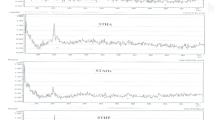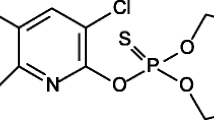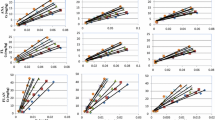Abstract
Sorption characteristics of phenanthrene were studied in batch equilibrium experiments with 32 Australian soils that varied widely in physicochemical properties. Sorption of phenanthrene varied widely among the soils and was generally nonlinear, with the nonlinearity index (n) of the Freundlich isotherm varying from 0.62 to 1.01. Simple regression analyses revealed that total organic carbon (TOC) accounts for about 68 % of the variation in the partition coefficient (K′ f ) for sorption among the soils at an equilibrium concentration (C e ) of 0.05 mg/L. The organic carbon normalized distribution coefficient (K OC ), varied considerably between soils with >70 % of the variance of logK OC being accounted for by logTOC, clay and log dissolved organic carbon (DOC). These results show that the phenanthrene C e is influenced by both TOC as well as the DOC in soil suspensions. The effects of ionic strength (IS) and index cation were investigated using four contrasting soils. Results show that with an increase in IS from 0.03 to 0.15 M sorption of phenanthrene generally increased in CaCl2 background solutions, whereas the effect was less significant and variable in NaCl background solutions. Sorption of phenanthrene was slightly higher at low IS (0.03 M) with Na+ as index cation compared with that of Ca2+, whereas an opposite trend was observed at higher IS (0.15 M). For two soils high in TOC, the flocculation of endogenous DOC in the presence of Ca2+ reduced the influence of background electrolyte and resulted in a more linear sorption isotherm as well as higher sorption capacity. This trend was more significant with Ca2+ relative to Na+.







Similar content being viewed by others
References
Ahangar, A. G., Smernik, R. J., Kookana, R. S., & Chittleborough, D. J. (2008). Separating the effects of organic matter–mineral interactions and organic matter chemistry on the sorption of diuron and phenanthrene. Chemosphere, 72(6), 886–890.
Bonin, J. L., & Simpson, M. J. (2006). Variation in phenanthrene sorption coefficients with soil organic matter fractionation:the result of structure or conformation? Environmental Science & Technology, 41(1), 153–159.
Carmo, A. M., Hundal, L. S., & Thompson, M. L. (2000). Sorption of hydrophobic organic compounds by soil materials: application of unit equivalent Freundlich coefficients. Environmental Science & Technology, 34(20), 4363–4369.
CCME. (2010). Canadian environmental quality guidelines—Canadian soil quality guidlines for the protection of environmental and human health. Quebec: National Guidelines and Standards Office.
Chen, Z., Xing, B., & McGill, W. B. (1999). A unified sorption variable for environmental applications of the Freundlich equation. Journal of Environmental Quality, 28(5), 1422–1428.
Chiou, C. T. (1989). Theoretical considerations of the partition uptake of nonionic organic compounds by soil organic matter. In B. L. Sawhney & K. Brown (Eds.), Reactions and movement of organic chemicals in soils (pp. 1–29). Madison, USA: Soil Science Society of America.
Chiou, C. T. (2002). Partition and adsorption of organic contaminants in environmental systems. Hoboken, N.J: Wiley.
Chiou, C. T., & Kile, D. E. (1998). Deviations from sorption linearity on soils of polar and nonpolar organic compounds at low relative concentrations. Environmental Science & Technology, 32(3), 338–343.
Chiou, C. T., Peters, L. J., & Freed, V. H. (1979). A physical concept of soil–ater equilibria for nonionic organic compounds. Science, 206(4420), 831–832.
Chiou, C. T., McGroddy, S. E., & Kile, D. E. (1998). Partition characteristics of polycyclic aromatic hydrocarbons on soils and sediments. Environmental Science & Technology, 32(2), 264–269.
De Jonge, L. W., Moldrup, P., de Jonge, H., & Celis, R. (2008). Sorption and leaching of short-term-aged PHAs in eight European soils: link to physicochemical properties and leaching of dissolved organic carbon. Soil Science, 173(1), 13–24.
Delle Site, A.: 2001, Factors affecting sorption of organic compounds in natural sorbent/water systems and sorption coefficients for selected pollutants. A review, Journal of Physical and Chemical Reference Data, 30187–439.
Douben, P. E. T. (2003). PAHs: an ecotoxicological perspective. Chichester: Wiley.
Fall, C., Chaouki, J., Chavarie, C., & Elena-Ortega, R. (2003). Multivariate study on phenanthrene sorption in soils. Journal of Environmental Engineering, 129(11), 1030–1040.
Fitzpatrick, R., Boucher, S., Naidu, R., & Fritsch, E. (1994). Environmental consequences of soil sodicity. Soil Research, 32(5), 1069–1093.
Gee G. W., and J. W. Bauder. (1986), Methods of soil analysis, part 1, physical and mineralogical methods. Particle-size Analysis, pp. 383–411.
Gillman, G. P., & Sumpter, E. A. (1986). Modification to the compulsive exchange method for measuring exchangecharacteristics of soils. Australian Journal of Soil Research, 24(1), 61–66.
Huang, W., Young, T. M., Schlautman, M. A., Yu, H., & Weber, W. J. (1997). A distributed reactivity model for sorption by soils and sediments. 9. General isotherm nonlinearity and applicability of the dual reactive domain model. Environmental Science & Technology, 31(6), 1703–1710.
Isbell, R. F. (Ed.). (1996). The Australian soil classification. Melbourne, Australia: CSIRO Publishing.
Jarkko, A., & Jussi, V. K. K. (2001). Effects of water hardness and dissolved organic material on bioavailability of selected organic chemicals. Environmental Toxicology and Chemistry, 20(10), 2303–2308.
Jones, K. D., & Tiller, C. L. (1999). Effect of solution chemistry on the extent of binding of phenanthrene by a soil humic acid: A comparison of dissolved and clay bound humic. Environmental Science & Technology, 33(4), 580–587.
Karickhoff, S. (1984). Organic pollutant sorption in aquatic systems. Journal of Hydraulic Engineering, 110(6), 707–735.
Karickhoff, S. W., Brown, D. S., & Scott, T. A. (1979). Sorption of hydrophobic pollutants on natural sediments. Water Research, 13(3), 241–248.
Kile, D. E., Chiou, C. T., Zhou, H. D., Li, H., & Xu, O. Y. (1995). Partition of nonpolar organic pollutants from water to soil sediment organic matters. Environmental Science & Technology, 29(5), 1401–1406.
Lee, C. L., Kuo, L. J., Wang, H. L., & Hsieh, P. C. (2003). Effects of ionic strength on the binding of phenanthrene and pyrene to humic substances: three-stage variation model. Water Research, 37(17), 4250–4258.
Luo, L., Zhang, S., Ma, Y., Christie, P., & Huang, H. (2008). Facilitating effects of metal cations on phenanthrene sorption in soils. Environmental Science & Technology, 42(7), 2414–2419.
Naidu, R., Merry, R., Churchman, G., Wright, M., Murray, R., Fitzpatrick, R., et al. (1993). Sodicity in South Australia—a review. Soil Research, 31(6), 911–929.
Naidu, R., Bolan, N. S., Kookana, R. S., & Tiller, K. G. (1994). Ionic-strength and pH effects on the sorption of cadmium and the surface charge of soils. European Journal of Soil Science, 45(4), 419–429.
Palasantza, P.-A. & Samara, C.: 2009, Adsorption-desorption of polycyclic aromatic hydrocarbons on different Greek soils, The 11th international conference on Environmental Science and Technology, Chania, Crete, Greece, pp. B684–B692
Pan, B., Ghosh, S., & Xing, B. (2008). Dissolved organic matter conformation and its interaction with pyrene as affected by water chemistry and concentration. Environmental Science & Technology, 42(5), 1594–1599.
Schwarzenbach, R. P. (1993). Environmental organic chemistry. New York: J. Wiley.
Snedecor, G. W., & Cochran, W. G. (Eds.). (1980). Statistical methods. Ames, Lowa: The Iowa University Press. 507 pp.
Turner, A., & Rawling, M. C. (2001). The influence of salting out on the sorption of neutral organic compounds in estuaries. Water Research, 35(18), 4379–4389.
Wauchope, R. D., Yeh, S., Linders, J. B. H. J., Kloskowski, R., Tanaka, K., Rubin, B., et al. (2002). Pesticide soil sorption parameters: theory, measurement, uses, limitations and reliability. Pest Management Science, 58(5), 419–445.
Acknowledgments
The authors would like to thank the University of SA and Cooperative Research Centre for Contamination Assessment and Remediation of the Environment (CRC CARE) for the award of scholarship and funding. The authors are grateful for the infrastructural support from the Centre for Environmental Risk Assessment and Remediation (CERAR), University of South Australia.
Author information
Authors and Affiliations
Corresponding author
Additional information
Guest Editors: R Naidu, Euan Smith, MH Wong, Megharaj Mallavarapu, Nanthi Bolan, Albert Juhasz, and Enzo Lombi
This article is part of the Topical Collection on Remediation of Site Contamination
Rights and permissions
About this article
Cite this article
Duan, L., Naidu, R. Effect of Ionic Strength and Index Cation on the Sorption of Phenanthrene. Water Air Soil Pollut 224, 1700 (2013). https://doi.org/10.1007/s11270-013-1700-4
Received:
Accepted:
Published:
DOI: https://doi.org/10.1007/s11270-013-1700-4




